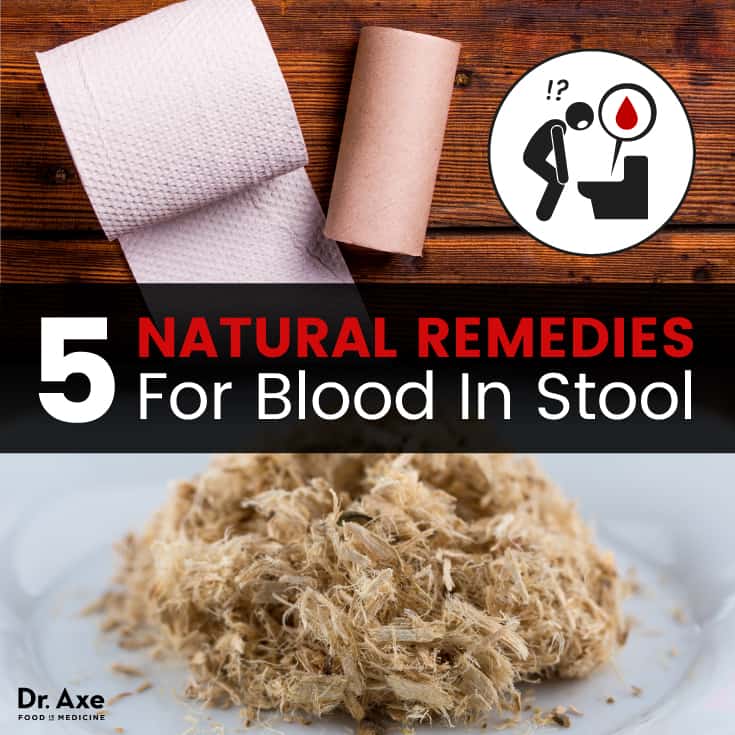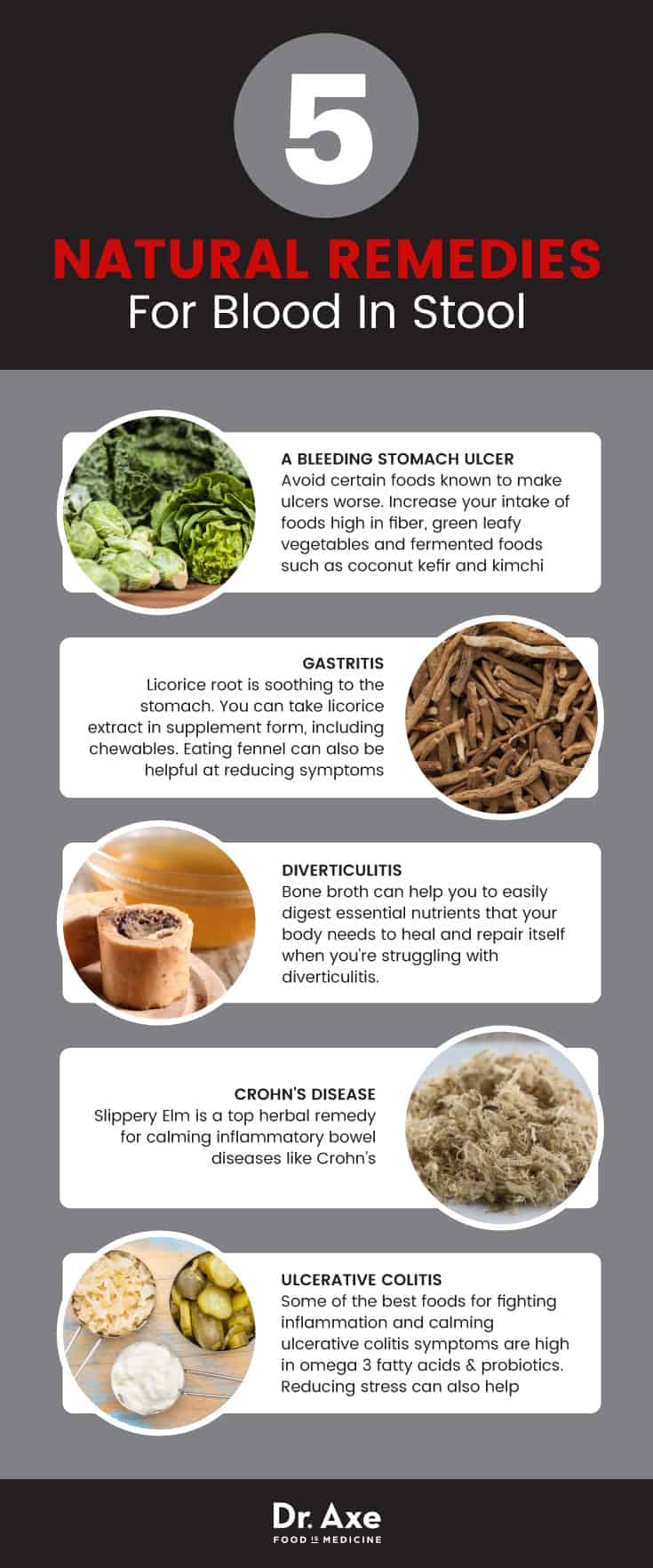
Seeing bright red blood in stool is no laughing matter, especially when it’s your own poop. Sometimes it can mean something serious is going on. Other times it may be minor and nothing to lose sleep over. But either way, pooping blood can be quite alarming and it’s not something to just ignore. (1)
Are you wondering “why is my poop black?” Many people don’t realize that a black stool is also a bloody stool. It’s true, blood in stool can result in black poop or bright red blood in poop. The color is actually very important to note. The coloring can point towards the internal source of bleeding. Bloody stools can also be a symptom of bleeding from the anus or rectal bleeding.
Of course, if you are having an excessive amount of blood loss, head straight for emergency medical care. If you are not having life-threatening blood loss or other symptoms in addition to blood in stool then there are some natural ways to help yourself, which all involve addressing the true root of your bloody stools. I’m about to tell you some of those possible causes as well as natural remedies to address each one.
What Is Blood in Stool?
Blood in stool is also referred to medically as hematochezia. When you go to the bathroom, your feces should normally be a shade of brown. When blood is present in the stool, then this referred to as hematochezia or blood in stool. Blood in stool is typically caused by bleeding coming from the upper or lower gastrointestinal tract. The blood in a stool can range from being bright red to black. The color of blood in stool can actually be indicative of the location of internal bleeding, if that is the cause. (2) Sometimes pooping blood is not from internal bleeding, but is actually a sign of active rectal bleeding.
The presence of blood in stool can also range from being not noticeable to the naked eye to being alarmingly obvious. I’ve previously written about Poop: What’s Normal & What’s NOT, which I highly recommend checking out. One thing I will tell you is that it’s never normal to see blood in your stool. It may not be an extremely serious situation, but it’s certainly not normal.
Signs & Symptoms
The main sign or symptom of blood in stool is exactly that: you see blood in your poop. It’s important to note that when you see stool color changes, such as the addition of blood to your stool, this is actually a health concern that points towards underlying cause. (3)
Sometimes someone may have blood in stool and not even know it because they don’t have any other symptoms and they haven’t noticed the blood in his or her stools. Other times, blood in stool can be accompanied by other concerning symptoms such as abdominal pain, weakness, breathing trouble, vomiting, heart palpitations, bloody diarrhea and/or weight loss. The possibility and type of symptoms in addition to blood in stool depend upon on the true root cause of the blood stools, how long the bleeding has taken place as well as how much blood has been lost. (4)
What about mucus in stool? It’s totally normal for your stool to contain a small amount of mucus. However, if you start to see more mucus in your stool, your bowel movements change, or you also see blood in stool, then you should see a doctor because it could be something more serious. (5)
Causes & Risk Factors
Blood in the stool can come from any place in your digestive system, from your mouth all the way to your anus. If the bleeding is coming from the upper digestive region (such as the esophagus or stomach), then this typically results in tarry or black poop, which is also medically referred to as melena. Maroon-colored stools or bright red blood often mean that the blood is coming from the small or large intestine, rectum or anus.
The blood in black or tarry stools is usually coming from upper GI bleeding and can be caused by: (6)
- Abnormal blood vessels
- A tear in the esophagus from violent vomiting (called Mallory-Weiss tears)
- Bleeding stomach ulcer
- Blood supply being cut off to part of the intestines
- Gastritis
- Trauma
- The presence of a foreign body
- Widened, overgrown veins in the esophagus and stomach
Bright red blood in stools or maroon-colored stools usually equates to blood coming from the small intestine, large intestine, rectum or anus and can be caused by: (7)
- Abnormal blood vessels
- Anal fissures
- Bowel ischemia
- Diverticulosis
- Foreign body or trauma
- Hemorrhoids (often the cause of bright red blood)
- Infection in the intestines
- Inflammatory bowel diseases including Crohn’s disease and ulcerative colitis
- Polyps or cancer in the colon or small intestine
As I said earlier, the color of the blood in your stools is highly important. How so? A black, tarry stool (also called melena) typically indicates that the bleeding is coming from somewhere in the upper part of the gastrointestinal tract. For example, an ulcer is a possible cause of a tarry black stool.
On the other hand, if your stools contain bright red blood or are maroon in color, then this often means there is an issue in the lower region of the digestive tract such as the colon. Examples of possible lower GI problems that cause red or maroon stools include diverticulitis and hemorrhoids. (8)

Conventional Treatment
Significant stool changes, including blood in stool, typically warrant testing to get to the root cause of the changes.
Some conventional testing possibilities that take place to determine the cause of blood in stool can include: (9)
- Angiography
- Barium studies
- Bleeding scan
- Blood work including a complete blood count and more
- Colonoscopy
- Double balloon enteroscopy
- Stool test
- Testing to determine if an H. pylori infection is present
- Upper endoscopy (EGD) or capsule endoscopy
The conventional medical treatment for blood in stool means conventionally treating the underlying cause. (10)
5 Natural Remedies for Blood in Stool
Similar to rectal bleeding, like conventional treatments for blood in stool, natural treatments also need to address the root cause. The following are some natural ways to improve blood in stool according to a variety of causes.
Here’s what you can do if your blood in stool is caused by:
1. A Bleeding Stomach Ulcer
Bleeding stomach ulcers, or peptic ulcers, are painful sores that develop in the lining of your digestive system. Seeing blood when you vomit or the go to the bathroom is a common sign of a bleeding ulcer. Thankfully, there are some things in your control that can help to naturally reduce ulcer symptoms and the likelihood of them bleeding. First, you’ll want to avoid certain foods known to make ulcers worse, including spicy foods, caffeine, alcohol, refined sugars and any food allergens. Simultaneously, you’ll want to increase your intake of foods high in fiber, green leafy vegetables and fermented foods such as coconut kefir and kimchi.
Research has also shown that consumption of cabbage juice can have an impressive healing effect on peptic ulcers. (11) Try my GI Healing Juice Recipe which includes cabbage juice, cucumber, aloe and ginger. Doesn’t that sound soothing to your gut? It really is.
Another helpful idea when dealing with ulcers is to try eating several smaller meals throughout the day to reduce taxation of the digestive system and relieve ulcer symptoms.
2. Gastritis
Gastritis is digestive health issue resulting from damage and inflammation of the gastric mucosa (the lining of the stomach and gastrointestinal tract). Symptoms of gastritis can actually be similar to ulcer symptoms. One of those shared symptoms is blood in stool. As usual, diet can really help to improve gastritis and unwanted gastritis symptoms. Overall, a healing gastritis diet will consist mostly of vegetables, fruits, high-quality proteins and healthy fats. Foods that are especially helpful are ones rich in probiotics, fiber, antioxidants like vitamin C, vitamin B12, electrolytes and omega-3 fatty acids. Again, you’ll want to avoid common triggers like spicy or very hot foods as well as naturally acidic foods like tomatoes and oranges.
Reducing stress is helpful to gastritis and so is not eating too close to your bedtime. I recommend leaving yourself about three to four hours between your dinner and going to sleep to fully digest.
Licorice root contains an anti-inflammatory compound called glycyrrhizic acid, which is known for its soothing effects on the stomach making it very helpful to gastritis as well as ulcers. Not only is glycyrrhizic acid anti-inflammatory, it also has been shown to have antioxidant, anti-tumor and antimicrobial abilities. (12) You can take licorice extract in supplement form, including chewables. Eating fennel can also be helpful at reducing symptoms.
3. Diverticulitis
Diverticulitis occurs when one or more small pouches (called diverticula) in the wall of the colon become inflamed. Homemade bone broth and bone broth protein powder are two great ways to improve the integrity of your gut. Bone broth can help you to easily digest essential nutrients that your body needs to heal and repair itself when you’re struggling with diverticulitis.
Getting enough high fiber foods in the diet on a regular basis is also key to improving diverticulitis. A diet that is too low in overall dietary fiber appears to up the chances of having active diverticulitis symptoms. (13)
Avoiding nonsteroidal anti-inflammatory medication (NSAIDs) is extremely important when you’re dealing with internal bleeding from diverticulitis or any other gastrointestinal tract bleeding for that matter. A study published in the Archives of Family Medicine finds that chronic use of NSAIDs is linked to the worst symptoms of diverticulitis, especially bleeding. (14)
4. Crohn’s Disease
There are a range of Crohn’s disease symptoms depending on the severity of inflammation. Blood in the stool is a common symptom of this disease. So how can you improve Crohn’s disease and its symptoms naturally? You’ll definitely want to look into trying a Crohn’s Disease Diet & Natural Treatment Plan.
When it comes to herbs that can help, slippery elm is a demulcent, which is a substance that protects irritated tissues and promotes their healing. Slippery elm is an herb that contains mucilage, a substance that becomes a slick gel when mixed with water. This mucilage coats and soothes the various areas of the digestive tract making it a top herbal remedy for calming inflammatory bowel diseases like Crohn’s. (15)
5. Ulcerative Colitis
If the blood in your stools stems from ulcerative colitis, there are many natural remedies for ulcerative colitis. One of the first steps in improving ulcerative colitis is evaluating and making necessary changes to your diet. I highly recommend following a healing diet and avoiding common trigger foods like overly processed dairy products, refined sugars, caffeine, alcohol, carbonated beverages and spicy foods. What kinds of foods do you want to get more of? Some of the best foods for fighting inflammation and calming ulcerative colitis symptoms are high in omega 3 fatty acids and probiotics.
Turmeric is another smart addition to the diet if you’re looking to calm ulcerative colitis and get rid of blood in your stools. Turmeric is available in fresh root form, as a spice or as a supplement. Studies have shown taking curcumin, an active component of turmeric, may even help some ulcerative colitis patients stay in remission once they improve their symptoms. (16)
Reducing stress and increasing intentional moments of relaxation are other key aspects of what you can personally do to improve your ulcerative colitis symptoms. Stress is known to cause ulcerative colitis flareups so make sure you are practicing natural stress reducing techniques on a regular basis.
If you’re dealing with blood in stool as the result of rectal bleeding, you should check out Rectal Bleeding Causes + 5 Natural Ways to Find Relief.
Precautions
Seek emergency medical care for blood in stool if you also have any of these additional symptoms:
- You’ve passed large amounts of blood
- Rapid heart rate
- Lightheadedness
- Weakness
Remember that beets and tomatoes can also temporary cause a reddening of the stool, so don’t be alarmed if you see red stools shortly after enjoying some beets. Consuming black licorice or blueberries can temporarily cause black stools. So can taking iron pills or bismuth medicines such as Pepto-Bismol. (17)
Polyps or cancer can also cause blood in stool. Polyps in the colon can start off as benign growths with no symptoms, but then they can get bigger, bleed or even become cancerous. In the United States, colorectal cancer is currently the third most common cancer and it can cause bleeding that goes unnoticed. It’s important to take notice of your stools and seek medical attention for unexplained bleeding.
See your doctor if you are experiencing bloody mucus in stool or mucus along with abdominal pain because these symptoms can point towards more serious problems such as ulcerative colitis, Crohn’s disease and even cancer. (18)
Always check with your doctor before starting any new supplements or making any changes to your diet if you are currently taking medication or have any ongoing health concerns. For example, licorice extract may not be right for you if you are struggling with high blood pressure.
Final Thoughts
When you get a paper cut on your finger and it bleeds, you probably don’t freak out. But if you see blood in your stool, you’re probably going to be pretty concerned and rightfully so. Unexplained bleeding in the body is never something to ignore. If you see blood in your stools, make sure you note the color and frequency because these are very helpful details for a health professional.
Of course, if bleeding is excessive or you have any other additional symptoms, seek urgent medical care. Whether you treat blood in stool conventionally, naturally, or with a mix of the two, make sure you know the root cause of your bloody stools. Knowing the root cause is what decides the proper methods of treatment. With proper treatment, hopefully your trips to the bathroom will quickly become carefree again.
Read Next: 7 Signs & Symptoms You Have Leaky Gut
From the sound of it, you might think leaky gut only affects the digestive system, but in reality it can affect more. Because Leaky Gut is so common, and such an enigma, I’m offering a free webinar on all things leaky gut. Click here to learn more about the webinar.
Source: Dr Axe

